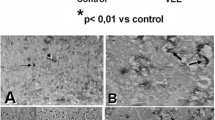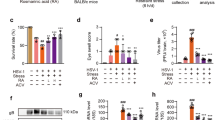Summary
In previous studies we have shown that various stress paradigms can induce the penetration of noninvasive, attenuated viruses into the central nervous system (CNS). Since glucocorticoids levels are elevated during stress, we compared the effect of cold stress and corticosterone (CS) injection on neuroinvasiveness of a non-invasive encephalitic virus, WN-25 (West Nile). Exposure of inoculated mice to cold stress or CS resulted in high viremia and a marked increase in mortality when compared to control untreated mice. Exposure of WN-25 inoculated mice to cold treatment or CS injection led to high blood virus levels as compared to nontreated mice (3.2 and 3.1 vs.>1 log 10 PFU/ml). Cold stress or CS (5 000 ng/mouse) treatment caused a mortality rate of 70% and 50% of the WN-25 inoculated mice respectively. No mortality was recorded in control inoculated groups (p<0.05). Passive transfer serum from uninfected cold stressed mice to WN-25 inoculated nonstressed mice, resulted in similar mortality. The levels of CS in passive transferred serum from cold stressed animals was 500 ng/ml, only 2% (100 vs. 5 000 ng) of the CS dose required to obtain a similar effect on viral penetration and mortality when CS was injected directly. Therefore, we concluded that CS was not the sole factor responsible for the cold stress effect on the viral infection outcome.
Similar content being viewed by others
References
Ader R (ed) (1981) Psychoneuroimmunology. Academic Press, New York
Ben-Nathan D, Lustig S, Feuerstein G (1989) The influence of cold or isolation stress on neuroinvasiveness and virulence of an attenuated variant of West Nile virus. Arch Virol 109: 1–10
Ben-Nathan D, Feuerstein G (1990) The influence of cold or isolation stress on resistance of mice to West Nile virus. Experientia 46: 285–292
Ben-Nathan D, Lustig S, Danenberg H (1991) Stress-induced neuroinvasiveness of a neurovirulent noninvasive Sindbis virus in cold or isolation subjected mice. Life Sci 48: 1493–1500
Ben-Nathan D, Kobiler D, Feuerstein G, Lustig S (1992a) Anti-stress effect of dehydroepiandrosterone (DHEA) on mice incoculated with attenuated arboviruses. Prog NeuroEndocrinImmunol 5: 229–234
Ben-Nathan D, Lustig S, Kobiler D, Danenberg H, Lupu E, Feuerstein G (1992) Dehydroepiandrosterone protects mice inoculated with West Nile virus and exposed to cold stress. J Med Virol 38: 159–166
Besedovsky H, Del Rey A, Sorkin E, Dinarello C (1986) Immunoregulatory feedback between Interleukin-1 and glucocorticoid hormones. Science 233: 652–654
Bonneau RH, She JF, Feng N, Glaser R (1991) Stress induced suppression of herpes simplex virus (HSV)-specific cytotoxic T lymphocyte and natural killer cell activity and enhancement of acute pathogenesis following local HSV infection. Brain Behav Immun 5: 170–192
Bonneau RH, Sheridan JF, Feng N, Glaser R (1993) Stress-induced modulation of the primary cellular immune response to herpes simplex virus infection is mediated by both adrenal-dependent and independent mechanisms. J Neuroimmunol 42: 167–176
Claman HN (1972) Medical progress. Corticosterone and lymphoid cells. N Engl J Med 287: 388–397
Claman HN (1984) Anti-inflammatory effects of corticosteroids. Clin Immunol Allergy 4: 317–329
Cohen S, Tyrrell DAJ, Smith P (1991) Psychological stress and susceptibility to the common cold. N Eng J Med 325: 606–612
Dantzer R, Kelley KW (1989) Stress and immunity: An integrated view of the relationships between the brain and the immune system. Life Sci 44: 1995–2008
Dinarello CA (1984) Interleukin-1 and the pathogenesis of the acute-phase response. N Engl J Med 311: 1413–1418
Dobbs CM, Vasquez M, Glaser R, Sheridan JF (1993) Mechanisms of stress-induced modulation of viral pathogenesis and immunity. J Neuroimmunol 48: 151–160
Dulbecco R, Vogt M (1956) Plaque formation and isolation of pure lines with poliomyelitis viruses. J Exp Med 99: 167–182
Dunn AJ, Powell ML, Meitin C, Small PA (1989) Virus infection as a stressor: influenza virus elevates plasma concentration of corticosterone and brain concentrations of MHPG and tryptophan. Physiol Behav 45: 591–594
Friedman SB, Glasgow LA, Ader R (1970) Differential susceptibility to viral agent in mice housed alone or in group. Psychosom Med 32: 285–299
Goetzl EJ, Sreedharan SP (1992) Mediators of communication and adaptation in the neuroendocrine and immune systems. FASEB J 6: 2646–2652
Goldien A (1987) Adrenocorticosteroids and adrenocortical antagonist. In: Katzung BG (ed) Basic and clinical pharmacology, 3rd ed. Appleton and Lange, Norwalk pp 449–460
Grossman CJ (1985) Interaction between the gonadal steroids and the immune system. Science 227: 257–260
Halevy M, Akov Y, Ben-Nathan D, Kobiler D, Lachmi B, Lustig S (1994) Loss of active neuroinvassiveness in attenuated strains of West Nile virus: pathogenicity in immunocompetent and SCID mice. Arch Virol 137: 355–370
Hermann G, Tovar CA, Beck FM, Sheridan JF (1994) Kinetics of glucocorticoid response to restraint stress and/or experimental influenza viral infection in two inbred strains of mice. J Neuroimmunol 49: 25–33
Jensen MM, Rasmussen AF (1963) Stress and susceptibility to viral infections. II. Sound stress and susceptibility to vesicular stomatitis virus. J Immunol 90: 21–23
Johnson T, Lavender JF, Multin E, Rasmussen F (1963) The influence of avoidance-learning stress on resistance to Coxsackie B virus in mice. J Immunol 91: 569–575
Khanshari DN, Murgo AJ, Faith RE (1990) Effect of stress on the immune system. Immunol Today 11: 170–175
Kobiler D, Lustig S, Gozes Y, Ben-Nathan D, Akov Y (1989) Sodium dodecylsulphate induces a breach in the blood brain barrier and enables a West Nile virus variant to penetrate into mouse brain. Brain Res 496: 314–316
Lustig S, Danenberg HD, Kafri Y, Kobiler D, Ben-Nathan D (1992) Viral neuroinvasion and encephalitis induced by lipopolysaccharide and its mediators. J Exp Med 176: 707–712
Lustig S, Halevy M, Ben-Nathan D, Akov Y (1992) A novel variant of Sindbis virus is both neurovirulent and neuroinvasive in adult mice. Arch Virol 122: 237–248
Parillo JE, Fauci AS (1979) Mechanisms of glucocorticoid action on immune processes. Ann Rev Pharmacol Toxicol 19: 179–201
Peterson PK, Chao CC, Molitor T, Murtaugh M, Strgar F, Sharp M (1991) Stress and pathogenesis of infectious disease. Revi Infect Dis 13: 710–720
Rasmussen AF, March JT, Brill NQ (1957) Increased susceptibility to herpes simplex in mice subjected to avoidance-learning stress or restrain. Proc Soc Exp Biol Med 96: 183–189
Riley V (1981) Psychoneuroendocrine influences on immunocompetence and neoplasia. Science 212: 1100–1109
Rogers MP, Dubey MD, Reich P (1979) The influence of the psyche and the brain on immunity and susceptibility: a critical review. Psychosom Med 41: 147–164
Roszman T, Carlson SL (1991) Neural-immune interactions: circuits and networks. Prog NeuroEndocrinImmunol 4: 69–78
Sternberg EM, Chrousos, GP, Wilder RL, Gold PW (1992) The stress response and the regulation of inflammatory disease. Ann Int Med 117: 854–866
Weigent DA, Blalock E (1987) Interactions between the neuroendocrine and immune systems: common hormones and receptors. Immunol Rev 100: 79–107
Author information
Authors and Affiliations
Rights and permissions
About this article
Cite this article
Ben-Nathan, D., Lustig, S. & Kobiler, D. Cold stress-induced neuroinvasiveness of attenuated arboviruses is not solely mediated by corticosterone. Archives of Virology 141, 1221–1229 (1996). https://doi.org/10.1007/BF01718826
Received:
Accepted:
Issue Date:
DOI: https://doi.org/10.1007/BF01718826




